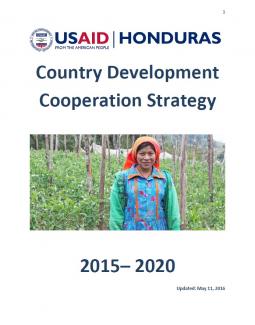Honduras’ fragile democracy is increasingly threatened by alarming levels of crime and violence, high levels of poverty and food insecurity, and generally weak governance. These threats to citizen security and economic development are so severe that the Government of Honduras (GOH) has requested outside assistance to address them. Failure to adequately counter these threats directly impacts U.S. security and other national interests. The USAID/Honduras Country Development Cooperation Strategy (CDCS) goal is a more prosperous and safer Honduras that advances inclusive social and economic development among vulnerable populations. USAID /Honduras’ emphasis extends to the social and economic development of vulnerable populations, those most at risk of crime and violence and those living below the poverty line, within Honduras to ensure that the economic trajectory of the country is not only upward but also equitable, inclusive, and sustainable. In order to achieve the CDCS goal, USAID will work towards two Development Objectives (DOs):
- DO 1: Citizen Security Increased For Vulnerable Populations In Urban, High-Crime Areas
- DO 2: Extreme Poverty Sustainably Reduced For Vulnerable Populations In Western Honduras
- DO 3: National-level public administration is more transparent and accountable
The CDCS in many ways anticipated the principles of the U.S. Strategy for Engagement in Central America, approved by the U.S. National Security Council in late 2014. The three pillars of security, prosperity, and governance are reflected in our CDCS: security issues are reflected for the most part in Development Objective 1; prosperity as it relates to poverty reduction is reflected in Development Objective 2; and governance programs are integrated into both objectives. Complementing the USG strategy, the GOH, together with the Governments of El Salvador and Guatemala, presented their own strategy, the Alliance for Prosperity, which calls for more rapid economic growth to mitigate poverty and crime in order to reduce the underlying causes behind migration to the USA. The USAID/Honduras CDCS for FYs 2015-2019 also reflects the goals of the U.S. Embassy’s FY 2014-2016 Integrated Country Strategy. Indeed, the momentum that has led to increased attention to the serious issues that persist in Honduras provides an opportunity for USAID/Honduras to strategically utilize additional resources resulting from the implementation of these regional plans.
In pursuit of the development goal, USAID collaborates and coordinates with a cross-sector of actors involved in resolving development challenges in Honduras. This includes other USG agencies such as the State Department’s Bureau of International Narcotics and Law Enforcement Affairs, the Departments of Agriculture and the Treasury, and the Millennium Challenge Corporation, as well as USG security and defense agencies. The success of this strategy will also rely upon strong partnerships with the GOH at national and local levels, community organizations and civil society, and the private sector.
DO1 programs will concentrate in high-density urban areas with notably high crime rates. These are Tegucigalpa, San Pedro Sula, Choloma, Tela, and La Ceiba. USAID/Honduras will empower those populations most vulnerable to crime and violence in Honduras with resources and opportunities to reduce their risk of becoming victims or perpetrators of crime or violence in their communities. Under DO1, USAID will scale-up successful programs which provide educational and off-street social opportunities for at risk youth, community infrastructure that mitigates crime, schools and classroom infrastructure to increase access for youth beyond the sixth grade, social services to address household and gender based violence, community policing, and public financial management in the GOH security and justice agencies.
While USAID/Honduras recognizes extreme poverty can be found throughout the country, activities under DO2 will be strategically focused on the six western departments, given the severe poverty, under-nutrition, and low education indicators in this geographic area. DO2 activities will be designed so that the poor will acquire the tools to sustainably increase their incomes through improved resource management and human capacity. National-level institutions will be assisted to scale-up and become more effective in the region, in many cases by decentralizing authority to local governments and institutions. This five–year period of USAID intervention will result in a reduction of both the number of families living on less than $1.25 per day per person (the international poverty level) and suffering malnutrition, as well as increased school completion rates and local government capacity.
The two DOs incorporate a well-reasoned mix of short- and long-term strategies to address the fundamental root causes of crime, violence, and poverty. Guided by USAID’s principles to maximize our impact through more strategic, focused, and result-oriented approaches, USAID/Honduras will strengthen integration among democracy and governance, economic growth, education, health, and CARSI (Central America Regional Security Initiative) activities which all contribute to crime prevention under DO1 and poverty reduction under DO2. The GOH has offered to increase their significant counterpart contributions for a scaling-up of these activities.
This CDCS is a living document that will be adapted to a progressive learning agenda, changes in the Honduran environment, as well as USG policies and resource availability.

